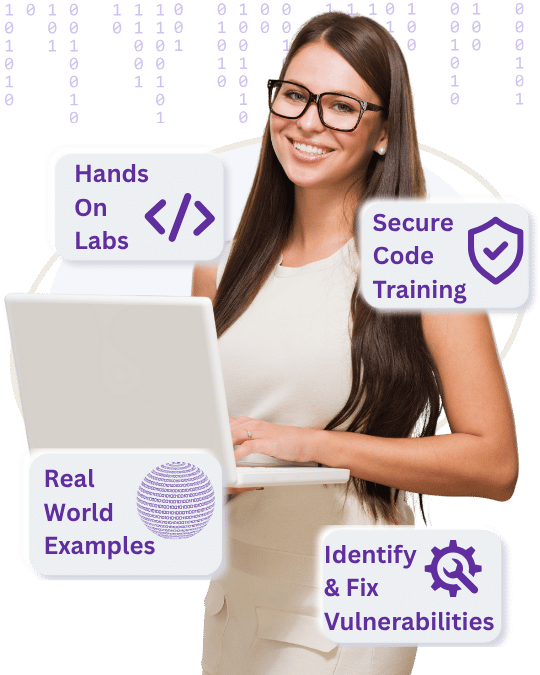Secure Coding for Developers – A Hands-On Workshop
Introduction
Secure code is the first line of defense in today’s software-driven world. With growing threats and increasing pressure to deliver faster, developers are expected to write secure applications by design. But the reality on the ground is different: many developers aren’t trained to think like attackers or to recognize how common coding patterns can lead to serious vulnerabilities.
Traditional training methods—often generic, overly theoretical, or detached from daily development challenges—rarely make a lasting impact. Developers need something more practical, contextual, and hands-on.
At QuadraLogics, we’ve built a secure coding workshop that does exactly that. This program focuses on real-world attack scenarios, language-specific risks, and direct code remediation, helping developers not just understand security concepts—but apply them.

Why This Workshop?
Organizations invest in scanners, checklists, and compliance audits—but none of that replaces the need for developers who understand how to write secure code from the start.
This workshop helps close that gap by focusing on:
- Practical security training grounded in the developer’s actual tech stack
- Real coding exercises that reflect actual application logic
- Threat scenarios and remediation techniques developers can use immediately
It’s a learning experience designed not just to inform, but to change how developers think about security in the context of their everyday work.
Who It’s For
This workshop is designed for:
- Frontend, backend, and full-stack developers
- Embedded system engineers
- DevOps and CI/CD practitioners
- QA engineers and SDETs involved in security testing
- Architects and team leads
Whether your team works in Java, C++, Python, JavaScript, .NET, or embedded C, the training is tailored to highlight the unique risks and practices for your stack.
What We Cover
Our content is modular and customizable. We start with the fundamentals and quickly move into deeper, language-specific issues developers actually face in the field.
Core Topics Include:
Secure Development Foundations
- Understanding the modern threat landscape
- Secure SDLC and the developer’s role
- Risk prioritization and attack surface analysis
OWASP Top 10 in Practice
- Broken Access Control
- Injection attacks (SQL, NoSQL, LDAP)
- Insecure Design flaws
- Cryptographic failures
- Security misconfigurations
- SSRF and other emerging risks
Web Application Security Essentials
- Cross-Site Scripting (XSS): All three types
- CSRF: How it works, and how to stop it
- Session security and token management
- Content Security Policy (CSP) and secure headers
- CORS, clickjacking, and insecure object references
Common Software Vulnerabilities (CSV)
- Insecure deserialization
- Race conditions and logic bugs
- Unsafe memory operations (for C/C++)
- Hardcoded secrets and sensitive data exposure
- Code injection in templating engines and shell calls
Advanced Topics (on request)
- DevSecOps best practices
- Secure Kubernetes and Docker usage
- Secure configuration of cloud SDKs
- Secure Infrastructure as Code (IaC) patterns
- Threat modeling and secure architecture reviews
Learning Through Code
Theory is important—but application is what makes it stick. In every session, we provide live coding demos, walkthroughs, and hands-on labs that simulate realistic scenarios. Developers learn by breaking things, fixing them, and understanding the implications behind the fix.
Typical hands-on activities include:
- Exploiting and patching an SQL Injection flaw
- Fixing XSS in a React or Angular front end
- Securing user authentication and session tokens
- Analyzing and securing deserialization logic
- Writing and reviewing secure code as a team
All labs are delivered in an isolated, guided environment where participants are free to experiment, learn, and ask questions without judgment.
Customization & Relevance
Security best practices are not universal—they depend on your architecture, language, and domain. That’s why we customize every workshop to:
- Your programming languages and frameworks
- The development tools and platforms your team uses
- The specific risks your business faces
- Your regulatory obligations (ISO, GDPR, NIA, etc.)
Whether your code runs on a medical device, mobile app, banking system, or cloud-native stack, we tailor the experience to fit.
Outcomes You Can Expect
Clients who’ve taken this training report meaningful improvements across several dimensions:
- Fewer recurring security bugs—issues caught earlier in the SDLC
- Faster time-to-fix for vulnerabilities post-deployment
- Higher developer confidence in handling security-sensitive code
- Improved collaboration between developers and security teams
- Better audit and compliance readiness
Teams leave this training with the skills and mindset to build secure software—not just as a requirement, but as a core part of engineering quality.
Delivery Format
| Format | Description |
|---|---|
| Duration | 2–5 days (customized based on depth) |
| Mode | Onsite, remote, or hybrid instructor-led |
| Group Size | Ideal for 10–25 participants per cohort |
| Tools | Code labs, IDEs, virtual sandbox, exploit walkthroughs |
| Reports | Pre/post assessment scores, feedback analytics, skill insights |
Summary
Security doesn’t happen in a silo. It begins with developers who understand the risks in their code—and know how to write defensively from day one.
QuadraLogics’ Secure Coding for Developers workshop is a practical, high-impact training experience designed to shift your engineering culture towards secure development—one line of code at a time.
If your teams build the software that powers your business, investing in their secure coding capabilities is not just smart—it’s essential.
Book a session or request a custom quote: info@quadralogics.com
Learn more at www.quadralogics.com
Practical skills. Real code. Security that sticks.
Cybersecurity Training for Enterprises
Build resilience in your workforce with industry-focused,hands-on, practical cybersecurity programs.
Contact Us

